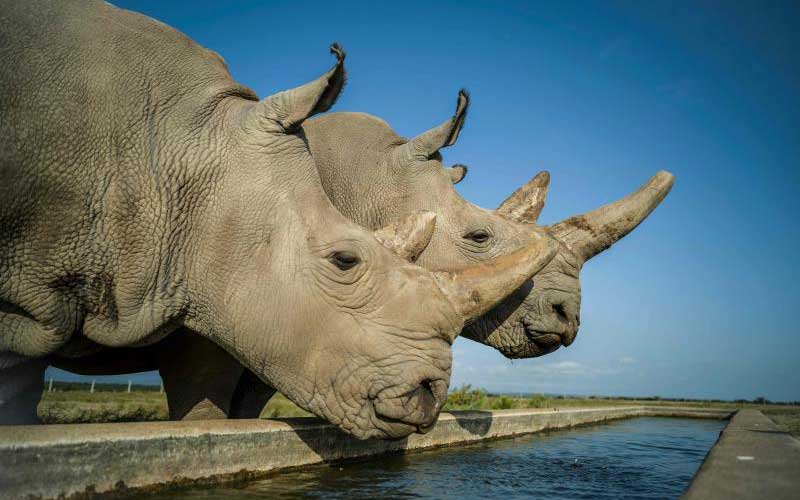The race to save the majestic northern white rhino from the verge of extinction is looking more hopeful.
Scientists announced today that they successfully created the third embryo using eggs harvested on December 17, 2019, from the two remaining subspecies and frozen sperm from dead males.
The last two northern white rhinos — Fatu and Najin are both female and are under the watchful eyes of horn-imbedded transmitters, watchtowers, fences, drones, guard dogs, and trained armed guards at Ol Pajeta Conservancy in Laikipia County. They cannot carry a pregnancy.
Sudan, the last male, died in March 2018 of poor health from age-related complications and extensive skin infections. His semen was collected in 2014.
The species-saving first two embryos were created in September 2019, a feat that marked a crucial turning point in saving the rare rhino. They are incubated in labs in Italy.
The international consortium of scientists and conservationists involved in the assisted reproduction say the third embryo was created over Christmas.
“We don’t know how many embryos we will need to achieve a successful birth of a new northern white rhino calf. That’s why every embryo is so important,” said Director of International Projects, Dvur Králové Zoo, Jan Stejskal.
Nine immature egg cells (oocytes) were harvested from the rhinos using a probe guided by ultrasound.
“After incubating and maturing nine eggs, four from Fatu and one from Najin were fertilised with sperm using a procedure called ICSI (Intra Cytoplasm Sperm Injection),” the team said in a statement.
Only one embryo was viable and is now stored in liquid nitrogen, waiting to be transferred into a surrogate mother in the near future.
The researchers noted that the development significantly increases the chances of successfully producing offspring.

The team said they are hopeful the transfer will be done this year, “despite the fact that more research is still needed”.
Ol Pejeta Conservancy Managing Director Richard Vigne was optimistic the news of a successful northern white pregnancy was not far.
“We have taken yet another small step along the road of saving the northern white rhino from extinction. We have a long way to go and success is far from assured, but Kenya continues to play her part at the centre of a multi-national collaboration to save this species”.
Tourism Cabinet Secretary Najib Balala welcomed the milestone, saying, it was amazing to see that they will be able to reverse the tragic loss of this subspecies through science.
“I urge the scientists to continue digging deeper into technology and innovations to ensure that not only this concerned species does not go extinct, but other species that are faced with similar threats,” he said, adding that it was a big win for Kenya.
There are only five remaining rhino species worldwide. Africa’s western black rhino was last spotted in 2006 with conservationists saying it was driven to extinction by poachers.
Credit: Source link